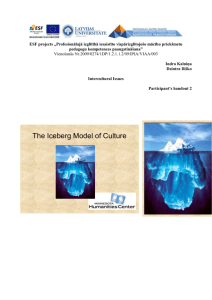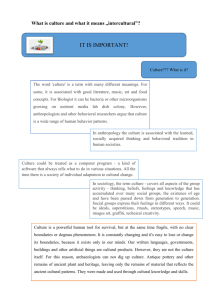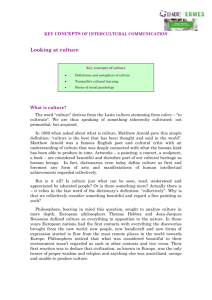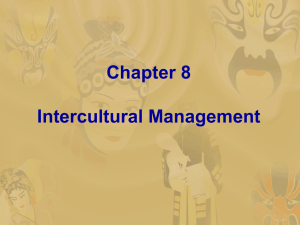Intercultural learning :
advertisement
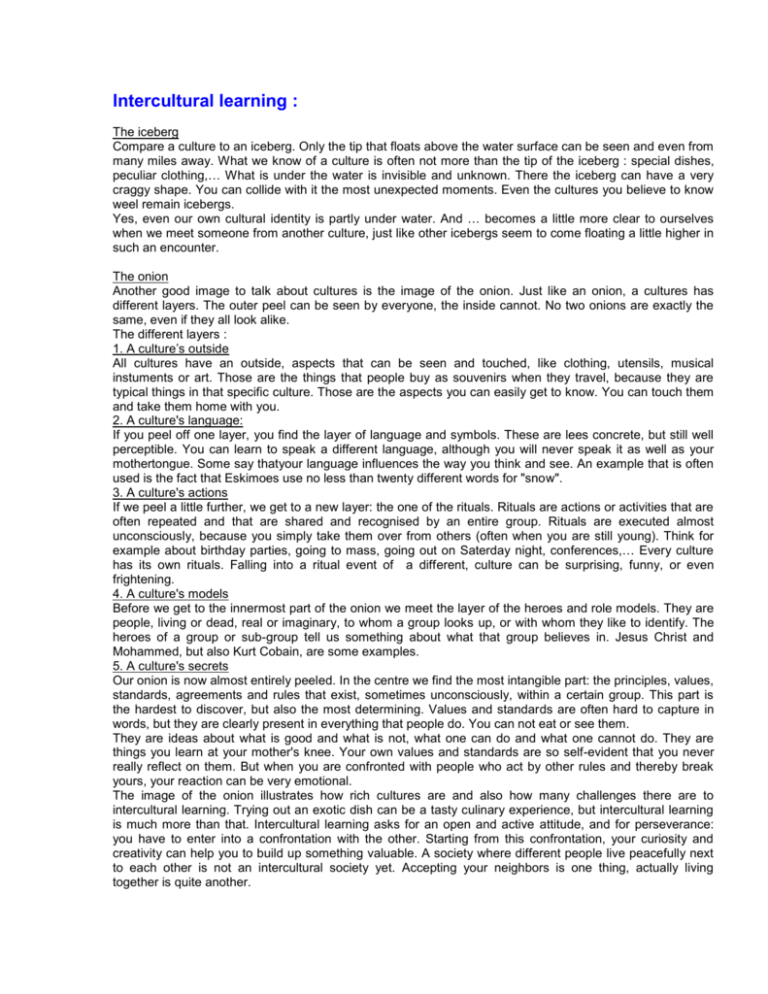
Intercultural learning : The iceberg Compare a culture to an iceberg. Only the tip that floats above the water surface can be seen and even from many miles away. What we know of a culture is often not more than the tip of the iceberg : special dishes, peculiar clothing,… What is under the water is invisible and unknown. There the iceberg can have a very craggy shape. You can collide with it the most unexpected moments. Even the cultures you believe to know weel remain icebergs. Yes, even our own cultural identity is partly under water. And … becomes a little more clear to ourselves when we meet someone from another culture, just like other icebergs seem to come floating a little higher in such an encounter. The onion Another good image to talk about cultures is the image of the onion. Just like an onion, a cultures has different layers. The outer peel can be seen by everyone, the inside cannot. No two onions are exactly the same, even if they all look alike. The different layers : 1. A culture’s outside All cultures have an outside, aspects that can be seen and touched, like clothing, utensils, musical instuments or art. Those are the things that people buy as souvenirs when they travel, because they are typical things in that specific culture. Those are the aspects you can easily get to know. You can touch them and take them home with you. 2. A culture's language: If you peel off one layer, you find the layer of language and symbols. These are lees concrete, but still well perceptible. You can learn to speak a different language, although you will never speak it as well as your mothertongue. Some say thatyour language influences the way you think and see. An example that is often used is the fact that Eskimoes use no less than twenty different words for "snow". 3. A culture's actions If we peel a little further, we get to a new layer: the one of the rituals. Rituals are actions or activities that are often repeated and that are shared and recognised by an entire group. Rituals are executed almost unconsciously, because you simply take them over from others (often when you are still young). Think for example about birthday parties, going to mass, going out on Saterday night, conferences,… Every culture has its own rituals. Falling into a ritual event of a different, culture can be surprising, funny, or even frightening. 4. A culture's models Before we get to the innermost part of the onion we meet the layer of the heroes and role models. They are people, living or dead, real or imaginary, to whom a group looks up, or with whom they like to identify. The heroes of a group or sub-group tell us something about what that group believes in. Jesus Christ and Mohammed, but also Kurt Cobain, are some examples. 5. A culture's secrets Our onion is now almost entirely peeled. In the centre we find the most intangible part: the principles, values, standards, agreements and rules that exist, sometimes unconsciously, within a certain group. This part is the hardest to discover, but also the most determining. Values and standards are often hard to capture in words, but they are clearly present in everything that people do. You can not eat or see them. They are ideas about what is good and what is not, what one can do and what one cannot do. They are things you learn at your mother's knee. Your own values and standards are so self-evident that you never really reflect on them. But when you are confronted with people who act by other rules and thereby break yours, your reaction can be very emotional. The image of the onion illustrates how rich cultures are and also how many challenges there are to intercultural learning. Trying out an exotic dish can be a tasty culinary experience, but intercultural learning is much more than that. Intercultural learning asks for an open and active attitude, and for perseverance: you have to enter into a confrontation with the other. Starting from this confrontation, your curiosity and creativity can help you to build up something valuable. A society where different people live peacefully next to each other is not an intercultural society yet. Accepting your neighbors is one thing, actually living together is quite another.

